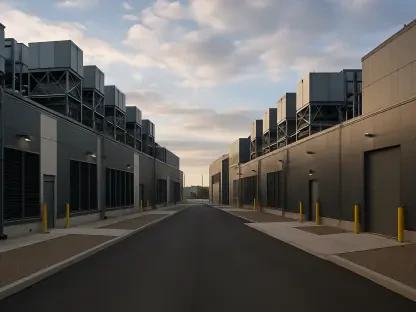At the intersection of environmental urgency and energy innovation, Canada’s clean energy landscape is navigating complex challenges and opportunities. The journey towards a sustainable future involves key shifts in policy, influenced by both political dynamics and economic considerations. Within this broad framework, the Peel Region emerges as a microcosm reflecting national priorities and challenges, highlighting the intricate lattice of decisions shaping Canada’s path forward.
Political Dynamics Influencing Energy Policies
Federal Government Initiatives
The Clean Electricity Regulations (CER) have become central to Canada’s climate strategy, targeting a reduction in carbon emissions from fossil fuel-based electricity production. This regulation represents a significant attempt to align Canada’s energy policy with global decarbonization efforts. While CER marks tangible progress in climate action, experts like Aliénor Rougeot from Environmental Defence argue for substantial enhancements to stimulate renewable energy demand more effectively. Improving grid flexibility and integrating advanced energy storage solutions are among the steps advocated to enhance CER’s efficacy in driving Canada’s energy transition.
Nonetheless, the CER’s journey is wrought with challenges, not least because it exists in a complex policy ecosystem influenced by various stakeholders. There’s a balance to be struck between regulatory measures and market dynamics to ensure efficient energy transitions without economic disruption. Moreover, as the federal government pushes these regulations, it must counteract political resistance, build public consensus, and ensure that related initiatives effectively integrate with other federal and provincial policies. Only then can the CER truly become an instrument of nationwide transformation rather than just a legislative milestone.
Conservative Party’s Counter-Proposals
The Conservative Party has unveiled a platform that promises financial prudence by proposing cuts to significant environmental programs, marking a stark shift from the current federal trajectory. Notably, this platform proposes dismantling the Impact Assessment Act, criticized by party leaders for hindering energy development. It also targets the repeal of the industrial carbon tax and federal electric vehicle mandates as fiscal measures to reduce national debt. However, this fiscal conservatism faces substantial opposition from climate advocates who argue dismantling these policies reverses crucial environmental progress.
The proposal to eliminate the Impact Assessment Act opens a debate on the balance between development and sustainability. While the Conservatives advocate for economic priorities, critics stress that environmental assessments are critical in ensuring long-term ecological health. The tension between short-term economic gains and sustainable growth models underscores wider questions about Canadian energy policy. As federal strategies oscillate between reform and rollback under differing political leaderships, the response to Conservative counter-proposals will dictate the nation’s environmental trajectory, potentially recalibrating the balance between fiscal responsibility and climate stewardship.
Economic Implications of Policy Changes
Fiscal Goals and Environmental Trade-offs
The Conservative platform’s fiscal goals highlight the trade-offs inherent in environmental policy changes, proposing significant cuts to environmental initiatives as a means to reduce the national deficit. Among the targets for repeal are the federal electric vehicle mandate and the industrial carbon tax, with critics cautioning that such moves could undermine Canada’s long-term economic stability. The tension between immediate fiscal relief and sustained environmental investments underscores a broader dilemma facing policymakers in balancing economic and ecological priorities.
Scrutinizing fiscal strategies, opponents argue that reducing investment in environmental policies may yield short-term savings but risks long-term economic vulnerability. The defensibility of these trade-offs hinges on the sustainability of proposed fiscal savings amidst projected climate-related economic costs. The conversation extends beyond fiscal analysis into the territory of economic resilience, challenging policymakers to develop strategies that accommodate both fiscal prudence and climate objectives. This nuanced debate illustrates how energy policies are not only environmental choices but pivotal economic decisions shaping Canada’s national prosperity.
Potential Economic Consequences
The proposed rollback on environmental regulations carries potential economic consequences that extend beyond immediate fiscal savings. Experts warn that reversing key climate regulations could impede progress in reducing carbon emissions, ultimately jeopardizing economic resilience in the face of climate-related impacts. The prospective repeal of the industrial carbon tax, a pivotal element of Canada’s carbon reduction strategy, raises alarms about potential backslides in emission reduction efforts and the associated economic costs.
The economic ramifications of dismantling such regulations include increased emissions and their corresponding impact on public health and infrastructure. These ripple effects amplify economic vulnerabilities, as climate-related disruptions strain federal and provincial resources. By undermining existing measures, the rollback complicates Canada’s ability to sustain long-term growth while maintaining environmental commitments. Addressing these complexities requires a reevaluation of economic frameworks that interconnect climate strategies with national competitiveness, urging policymakers to carefully weigh immediate fiscal outcomes against enduring economic and ecological imperatives.
Environmental Concerns and Industrial Lobbying
Threats to Existing Environmental Policies
The conservation and advancement of Canada’s environmental policies face marked threats under proposed conservative measures, raising concerns among climate advocates. Particular focus has been drawn to the potential dismantling of the Oil and Gas Sector Greenhouse Gas Emissions Cap, a policy essential in ensuring that industry growth aligns with cleaner practices. The legislative rollback would not only reverse momentum gained in emissions reduction but could also erode the integrity of Canada’s broader climate strategy, affecting the nation’s environmental goals significantly.
This development illustrates the tension between environmental policy adherence and industrial pressures, spotlighting the significant influence of industry lobbying. Critics argue that removing these regulations would lead to increased emissions, with substantial economic and environmental consequences. The prioritization of sector-specific gains, particularly for oil and gas industries, risks derailing national environmental objectives. The growing influence of industry stakeholders underscores the need for robust policy frameworks that balance economic development with stringent environmental standards, vital for Canada’s sustainable future.
The Role of Lobbying in Policy Shaping
Lobbying practices, particularly by the oil and gas sector, wield considerable influence over Canada’s energy policies. Environmental advocacy groups have identified sustained efforts by this industry to cultivate relationships with opposition parties, a strategic preparation for potential shifts in power. These interactions exemplify the pervasive impact of industrial lobbying on policy directions, often positioning economic interests over environmental priorities and shaping energy strategies to favor profitable outcomes over sustainable practices.
The interplay between lobbying and legislative development reveals strategic dimensions in energy policy formation, where industry players significantly impact regulatory frameworks. Recognizing these patterns of influence underscores the critical need for transparency and accountability in policy-making processes. Also, addressing the extent of lobbying influence demands renewed legislative focus on collaborative models that integrate broader societal interests into policy development, ensuring that energy strategies align with long-term sustainable objectives rather than short-term industrial gains.
Clean Energy Projects at Stake
Local Initiatives and Federal Uncertainty
Local initiatives in the Peel Region and the Greater Toronto and Hamilton Area (GTHA) are integral to advancing Canada’s clean energy agenda, yet face potential disruption amid shifting federal policies. Notably, projects like Mississauga’s Lakeview Village district energy system, a substantial investment in clean technology, represent regional efforts to decarbonize energy infrastructure. However, with federal policies in flux due to proposed conservative rollbacks, such initiatives encounter uncertainty, emphasizing the need to maintain federal support to sustain momentum in local energy transformations.
These projects not only symbolize regional commitment to clean energy but also exemplify the potential impacts of federal uncertainties on local progress. As federal policy landscapes alter, regional endeavors must navigate new funding environments and policy priorities. This evolving scenario necessitates strategic alignment between federal objectives and local actions, highlighting the importance of coordinated policies that ensure regional initiatives receive the necessary backing for successful implementation. This alignment would serve as a backbone to Canada’s national energy objectives, underscoring the interconnected nature of clean energy initiatives across different governance levels.
The Critical Need for Federal Support
To bolster regional clean energy efforts, experts like Tony Iacobelli emphasize the necessity of increased federal support for key projects. Enhancing district energy systems requires not only substantial funding but also incentives that drive energy efficiency upgrades, often neglected in current platforms. The urgent call for federal commitment extends beyond financial contributions, advocating for frameworks that explicitly incorporate energy efficiency as a core component of national energy policy.
Federal support is pivotal in overcoming challenges inherent in regional clean energy projects, serving as a catalyst for local transformation. Addressing gaps in current allocations and optimizing incentive mechanisms could unlock the potential of regional clean energy initiatives, critical for Canada’s broader sustainability objectives. By institutionalizing comprehensive support, the federal government could foster advancements in energy transitions that align local innovations with national goals, illustrating a unified strategy in pursuing a green energy future.
Disparities in Policy Support and Supply Chain Challenges
Unequal Credits and Support Levels
Policy support for clean energy projects reveals stark disparities, particularly when comparing the private sector to municipalities and Indigenous nations. While private enterprises often enjoy financial credits for clean energy initiatives, municipal and Indigenous projects frequently experience gaps in funding and support, highlighting inequalities within energy policy frameworks. These inconsistencies present significant barriers to inclusive energy transitions, necessitating equitable credit distribution to advance local clean energy strategies effectively.
Addressing these disparities requires a recalibrated approach that recognizes the distinct challenges faced by different sectors and stakeholders. Equalizing support levels could bridge policy gaps and remove obstacles hindering comprehensive and inclusive energy developments. Ensuring that policy frameworks account for diverse needs across sectors reinforces a commitment to a cohesive national energy strategy, where all regions and communities benefit equitably from Canada’s clean energy transition, advancing both environmental goals and social equity.
Strengthening Domestic Supply Chains
The growing necessity for reliable clean technology supply chains spotlights Canada’s dependency on imports for critical components. This reliance presents unique challenges and opportunities in strengthening domestic manufacturing, a pivotal factor in achieving a sustainable energy transition. Diversifying supply chains through strategic initiatives could boost local industries, unlocking both public and private capital essential for meeting renewable energy demands sustainably.
Building robust domestic supply chains extends beyond manufacturing efforts, involving comprehensive policy measures that incentivize innovation and support development within Canada’s clean technology sector. Positioning domestic industries to compete on a global scale requires an integrated approach that aligns economic objectives with environmental goals, ensuring energy solutions are sustainable, reliable, and economically viable. Such efforts are critical to establish Canada as a leader in clean energy technology, mitigating import dependencies and ensuring national energy security in future transitions.
Broader Economic Development and Competitiveness
Opportunities in Accelerating Energy Transition
Seizing the opportunities presented by accelerating the energy transition could significantly bolster Canada’s economic development and international competitiveness. By adopting innovative policy frameworks, Canada can tap into the multifaceted benefits of a sustainable energy future, fostering both economic growth and environmental stewardship. Advancements in renewable technologies and efficiency-focused practices offer pathways to enhance global positioning while addressing domestic energy needs sustainably.
Pioneering energy transitions emphasize the importance of integrating innovative strategies into policy decisions that capitalize on emerging market trends. Cultivating a competitive edge necessitates a holistic approach, incorporating sustainability as a central tenet of economic planning. Strategic investments in clean energy not only align with international climate goals, but also drive industrial growth, positioning Canada as an industry leader, poised to influence global energy dynamics. Such a balanced strategy ensures economic competitiveness and adherence to environmental priorities in a rapidly evolving energy landscape.
Risks of Proposed Conservative Policies
At the crossroads of environmental urgency and energy innovation, Canada’s clean energy landscape is facing a complex web of challenges and opportunities. As the nation strives toward a more sustainable future, significant changes in policy are required, influenced heavily by political dynamics and economic factors. This journey involves adopting renewable energy technologies and changing how policies are prioritized and implemented. Within this expansive context, the Peel Region serves as a focused example, illustrating how national priorities and challenges play out on a more localized level. In this region, decisions and strategies mirror the broader intricacies that influence Canada’s advancement toward a cleaner and more sustainable energy future. The Peel Region acts as a microcosm, shedding light on the various decisions that collectively shape Canada’s pathway forward. Here, collaboration between governmental bodies, industry leaders, and communities becomes crucial, as each stakeholder plays a role in navigating the transition toward clean energy. Understanding and addressing these layered complexities not only supports regional progress but also informs and influences larger national objectives, highlighting the continuous interplay between local actions and Canada’s overarching goal of sustainability and innovation in energy practices.









